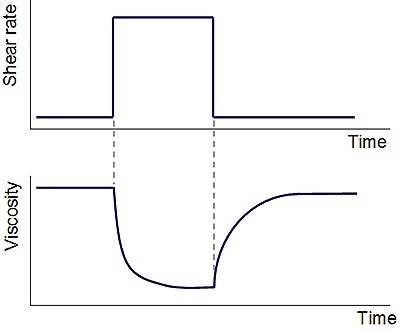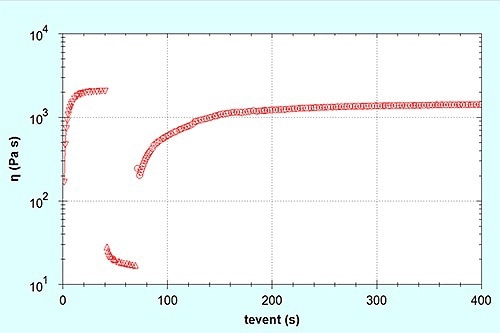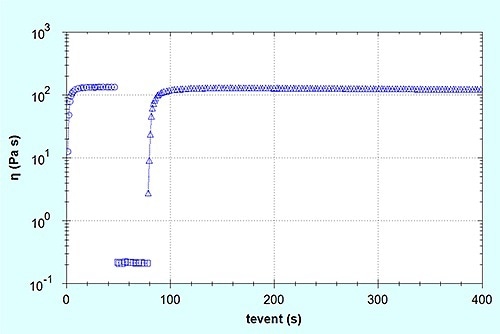Packaging of a number of consumer products is done in tubes or bottles wherein product application involves pumping the product through a nozzle.
These products are basically shear-thinning products where viscosity decreases during the extrusion method because of the increasing shear rate but improves when it exits the orifice as the shear rate is decreased.
The shear rate that occurs during this method is related to the radius, r of the orifice and the volumetric flow rate Q as expressed by the following formula:

The power law index is parameter n , which represents between 0 and 1 for a non-Newtonian fluid and 1 for a Newtonian liquid. This value is derived from a variable shear rate test by fitting a power law model to the ensuing data.

Figure 1. Thixotropy during a step rate test.
The shear rate at the time of extrusion can be estimated by measuring the volumetric flow rate and the internal radius of the orifice. This value can be input into a step shear rate test (Figure 1.) which shears the sample at a low shear rate for a specified time before increasing the shear rate of interest. This analysis reveals the speed at which the sample reclaims its viscosity after the extrusion method and points out the product’s thickness/viscosity at time of use.
The thixotropic features can be listed by calculating the final viscosity at the end of the first phase and the time it takes for a detailed % of that viscosity to be reclaimed during the final phase of the analysis.
This value can be used for studied between products/formulations and is relevant for a number of applications and industries.
Experimental
The following was tested during the experiments:
- The viscosity recovery properties of body lotion and toothpaste were tested under shear rate conditions connected with product extrusion during use
- Using a Kinexus rotational rheometer with a roughened parallel plate measuring unit and a Peltier plate cartridge, the rotational rheometer measurements were calculated. Also the standard pre-configured sequences in the rSpace software was used for this purpose.
- A basic loading series was used to make certain that both samples were exposed to a steady and restricted loading protocol
- The temperature set for all rheology measurements was 25°C
- The relevant extrusion shear rates were automatically measured as part of the test series with the aid of the input values of extrusion time, extruded volume, and aperture radius.
- Test programming was done to use this calculated value as the transitional shear rate in a step shear rate test with step 1 and step 2 using a constant shear rate of 0.1s-1
The time to reclaim 90% of the products unique viscosity was automatically determined and reported when the analysis was completed.
Results and Discussion
The automatic calculator analysed the shear rate for extrusion for product delivery to be and 840 s-1 for the body lotion and 34 s-1 for the toothpaste. These values were used in the transitional stage of the test. Figure 1 displays the results for the toothpaste. Therefore indicating that this was a highly thixotropic material as it did not completely reclaim its structure during the course of the analysis, reaching only 70 percent of its unique viscosity and requiring about 6 min to attain this level of recovery.
On the other hand, the body lotion shown in Figure 2 reclaimed most of its unique viscosity taking only 7 sec to reach the same % recovery as the toothpaste and 23 sec to reach 90 percent recovery. Therefore this material could be classified as essentially non-thixotropic in comparison.

Figure 2. Step shear rate curves for a toothpaste.

Figure 3. Step shear rate curves for a body lotion.
This is ideal when a consumer uses the product. The body lotion tends to restructure speedily after coming in contact with the skin, therefore preventing too much spreading or dripping. The toothpaste on the other hand had a lower viscosity on the brush prior to brushing thereby making it easier to spread in the mouth and impact the sensory properties. It is significant, however, that the viscosity is not so low that the product can flow via the bristles or sag on the brush.
Conclusion
A three-step shear rate investigation was conducted on a toothpaste and body lotion to test the amount of viscosity recovery following extrusion from a tube and bottle respectively. The toothpaste displayed high thixotropic level taking 6 min to recover 70 percent of its unique viscosity. The body lotion reached the same intensity of recovery in 7 sec and could be treated as non-thixotropic in comparison.

This information has been sourced, reviewed and adapted from materials provided by Malvern Panalytical.
For more information please visit Malvern Panalytical.